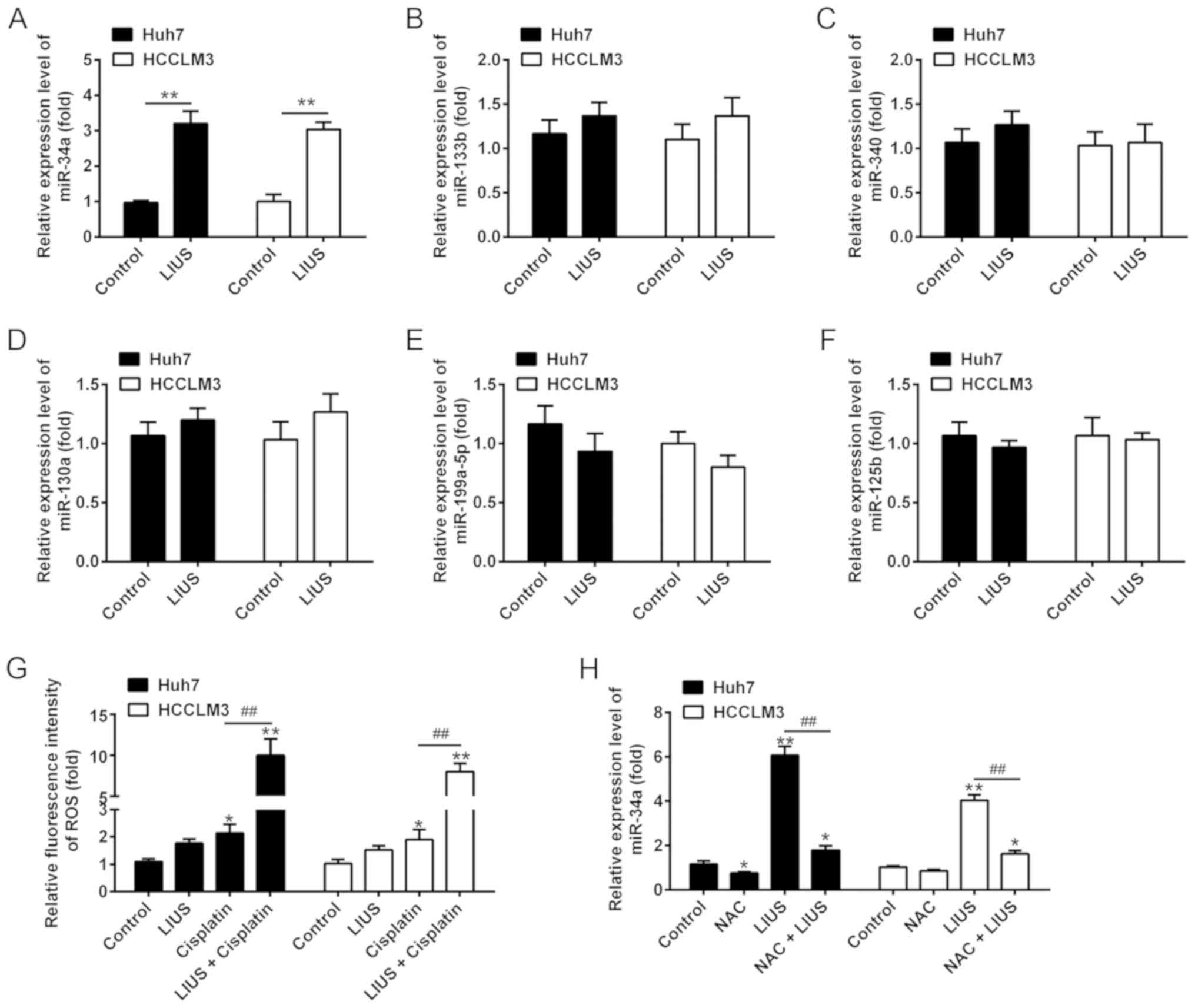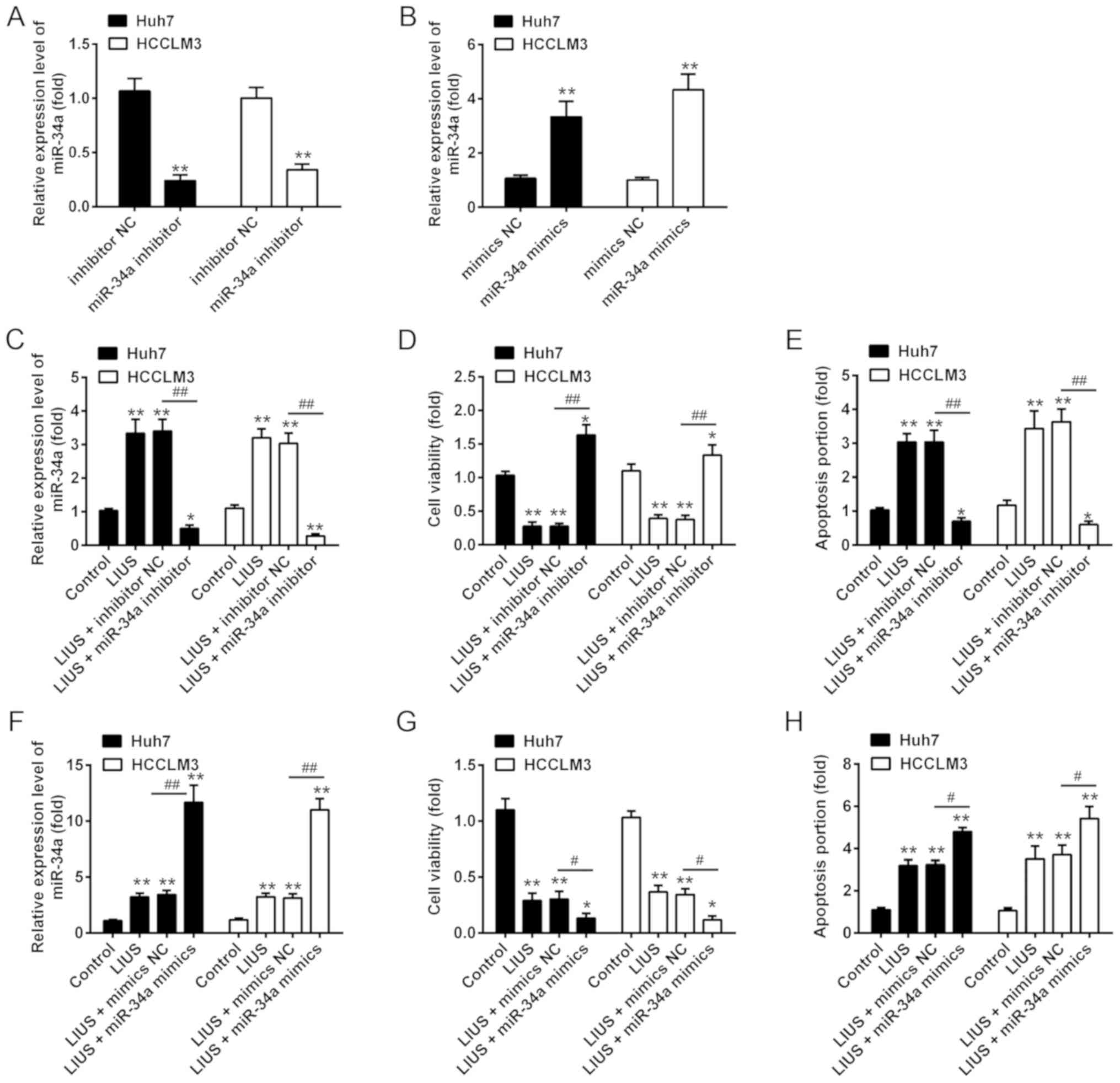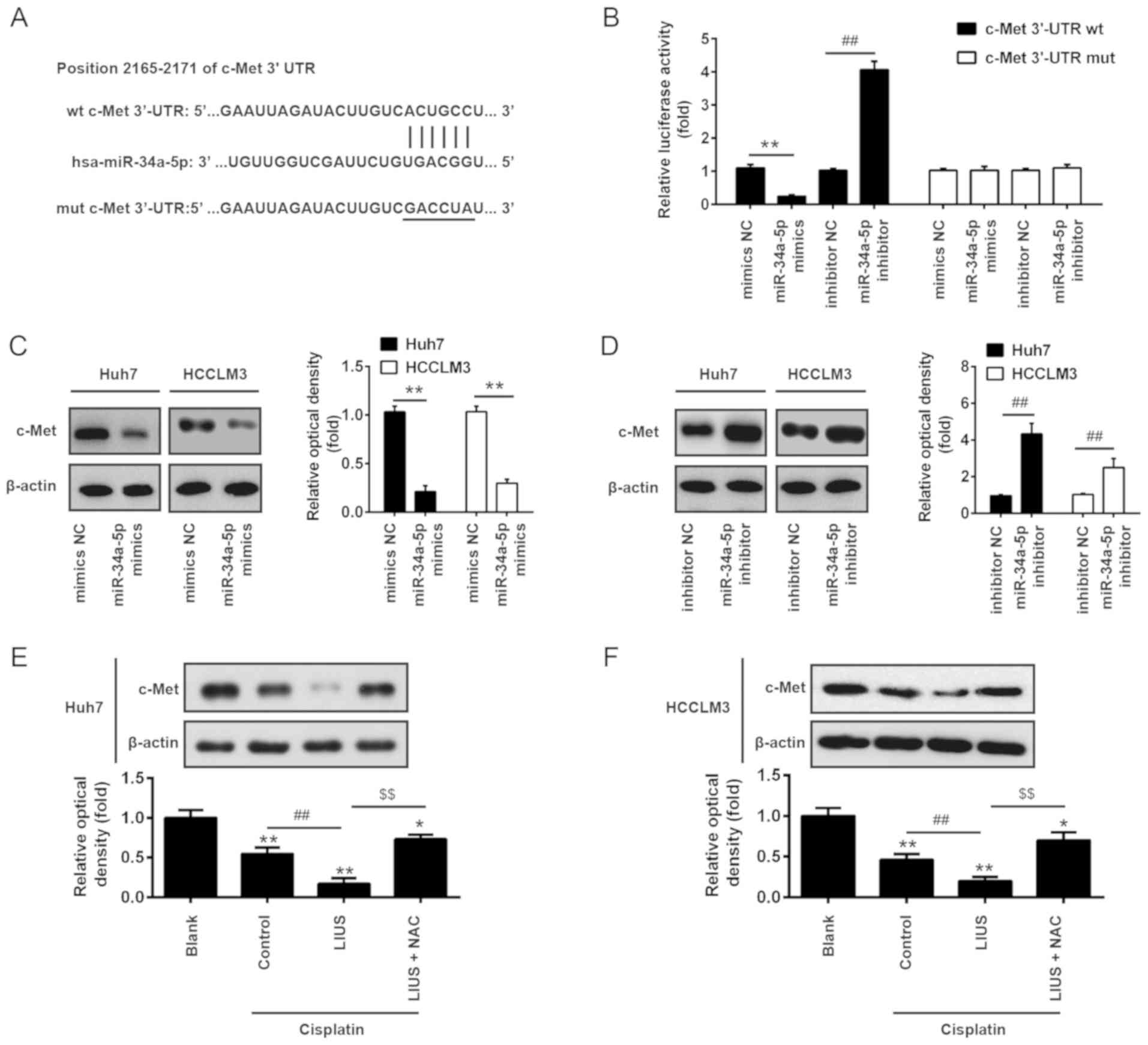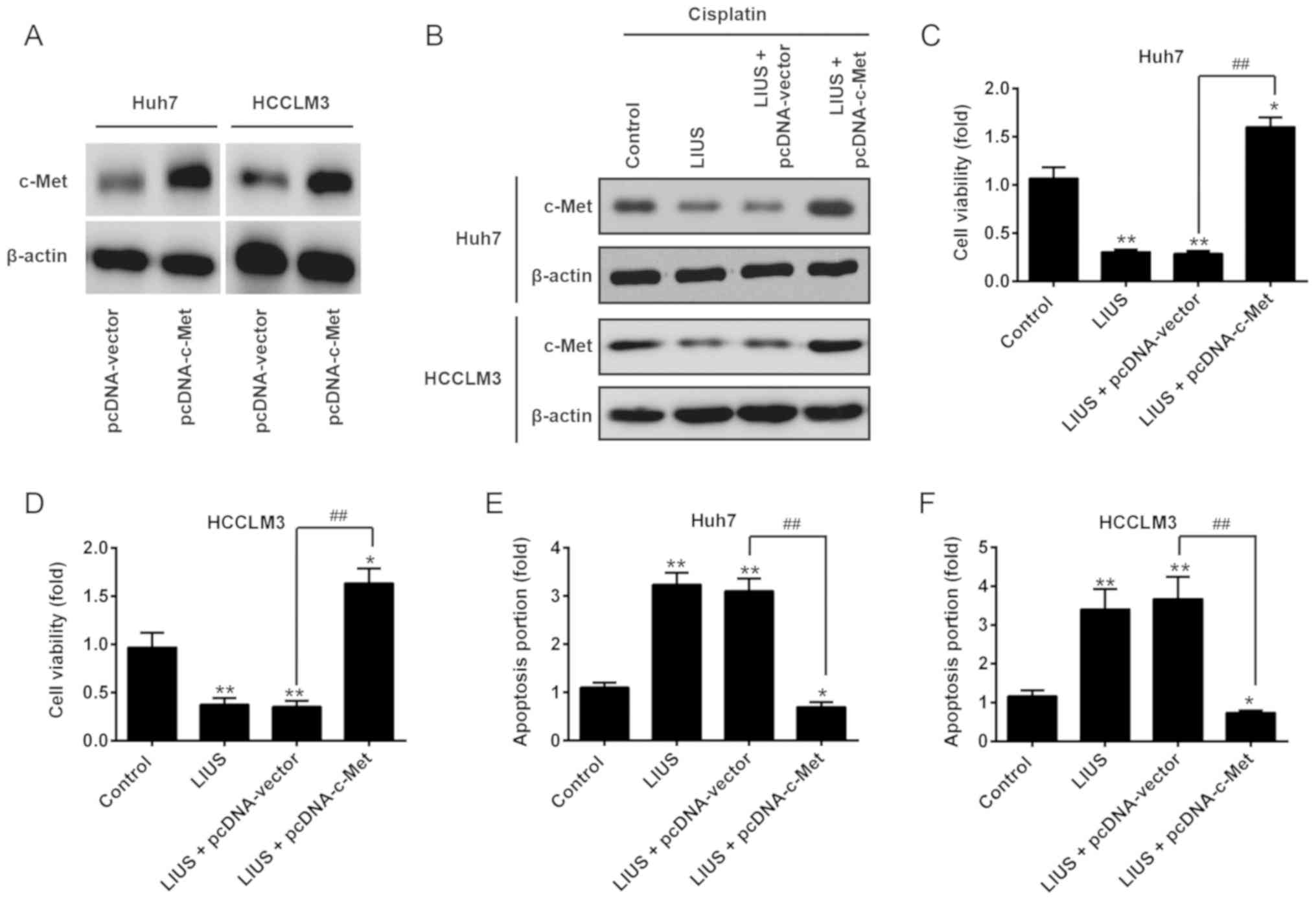|
1
|
Sapisochin G, de Sevilla EF, Echeverri J
and Charco R: Management of 'very early' hepatocellular carcinoma
on cirrhotic patients. World J Hepatol. 6:766–775. 2014. View Article : Google Scholar : PubMed/NCBI
|
|
2
|
Faloppi L, Scartozzi M, Maccaroni E, Di
Pietro Paolo M, Berardi R, Del Prete M and Cascinu S: Evolving
strategies for the treatment of hepatocellular carcinoma: From
clinical-guided to molecularly-tailored therapeutic options. Cancer
Treat Rev. 37:169–177. 2011. View Article : Google Scholar
|
|
3
|
Allemani C, Matsuda T, Di Carlo V,
Harewood R, Matz M, Nikšić M, Bonaventure A, Valkov M, Johnson CJ,
Estève J, et al: CONCORD Working Group: Global surveillance of
trends in cancer survival 2000-14 (CONCORD-3): Analysis of
individual records for 37 513 025 patients diagnosed with one of 18
cancers from 322 population-based registries in 71 countries.
Lancet. 391:1023–1075. 2018. View Article : Google Scholar : PubMed/NCBI
|
|
4
|
Thomas MB, O'Beirne JP, Furuse J, Chan AT,
Abou-Alfa G and Johnson P: Systemic therapy for hepatocellular
carcinoma: Cytotoxic chemotherapy, targeted therapy and
immunotherapy. Ann Surg Oncol. 15:1008–1014. 2008. View Article : Google Scholar : PubMed/NCBI
|
|
5
|
Fan H, Li H, Liu G, Cong W, Zhao H, Cao W
and Zheng J: Doxorubicin combined with low intensity ultrasound
suppresses the growth of oral squamous cell carcinoma in culture
and in xenografts. J Exp Clin Cancer Res. 36:1632017. View Article : Google Scholar : PubMed/NCBI
|
|
6
|
Tomizawa M, Ebara M, Saisho H, Sakiyama S
and Tagawa M: Irradiation with ultrasound of low output intensity
increased chemosensitivity of subcutaneous solid tumors to an
anti-cancer agent. Cancer Lett. 173:31–35. 2001. View Article : Google Scholar : PubMed/NCBI
|
|
7
|
Hu Z, Lv G, Li Y, Li E, Li H, Zhou Q, Yang
B and Cao W: Enhancement of anti-tumor effects of 5-fluorouracil on
hepatocellular carcinoma by low-intensity ultrasound. J Exp Clin
Cancer Res. 35:712016. View Article : Google Scholar : PubMed/NCBI
|
|
8
|
Bartel DP: MicroRNAs: Genomics,
biogenesis, mechanism, and function. Cell. 116:281–297. 2004.
View Article : Google Scholar : PubMed/NCBI
|
|
9
|
Melnik BC: miR-21: An environmental driver
of malignant melanoma? J Transl Med. 13:2022015. View Article : Google Scholar : PubMed/NCBI
|
|
10
|
Jajoo S, Mukherjea D, Kaur T, Sheehan KE,
Sheth S, Borse V, Rybak LP and Ramkumar V: Essential role of NADPH
oxidase-dependent reactive oxygen species generation in regulating
microRNA-21 expression and function in prostate cancer. Antioxid
Redox Signal. 19:1863–1876. 2013. View Article : Google Scholar : PubMed/NCBI
|
|
11
|
He J and Jiang BH: Interplay between
Reactive oxygen species and microRNAs in cancer. Curr Pharmacol
Rep. 2:82–90. 2016. View Article : Google Scholar : PubMed/NCBI
|
|
12
|
Simone NL, Soule BP, Ly D, Saleh AD,
Savage JE, Degraff W, Cook J, Harris CC, Gius D and Mitchell JB:
Ionizing radiation-induced oxidative stress alters miRNA
expression. PLoS One. 4:e63772009. View Article : Google Scholar : PubMed/NCBI
|
|
13
|
Yu T, Wang Z and Mason TJ: A review of
research into the uses of low level ultrasound in cancer therapy.
Ultrason Sonochem. 11:95–103. 2004. View Article : Google Scholar : PubMed/NCBI
|
|
14
|
Qi XF, Kim DH, Yoon YS, Kim SK, Cai DQ,
Teng YC, Shim KY and Lee KJ: Involvement of oxidative stress in
simvastatin-induced apoptosis of murine CT26 colon carcinoma cells.
Toxicol Lett. 199:277–287. 2010. View Article : Google Scholar : PubMed/NCBI
|
|
15
|
Yoshida T, Kondo T, Ogawa R, Feril LB Jr,
Zhao QL, Watanabe A and Tsukada K: Combination of doxorubicin and
low-intensity ultrasound causes a synergistic enhancement in cell
killing and an additive enhancement in apoptosis induction in human
lymphoma U937 cells. Cancer Chemother Pharmacol. 61:559–567. 2008.
View Article : Google Scholar
|
|
16
|
Watanabe Y, Aoi A, Horie S, Tomita N, Mori
S, Morikawa H, Matsumura Y, Vassaux G and Kodama T: Low-intensity
ultrasound and microbubbles enhance the antitumor effect of
cisplatin. Cancer Sci. 99:2525–2531. 2008. View Article : Google Scholar : PubMed/NCBI
|
|
17
|
Masui T, Ota I, Kanno M, Yane K and Hosoi
H: Low-intensity ultrasound enhances the anticancer activity of
cetuximab in human head and neck cancer cells. Exp Ther Med.
5:11–16. 2013. View Article : Google Scholar
|
|
18
|
McHale AP, Callan JF, Nomikou N, Fowley C
and Callan B: Sonodynamic therapy: Concept, mechanism and
application to cancer treatment. Adv Exp Med Biol. 880:429–450.
2016. View Article : Google Scholar
|
|
19
|
Wan GY, Liu Y, Chen BW, Liu YY, Wang YS
and Zhang N: Recent advances of sonodynamic therapy in cancer
treatment. Cancer Biol Med. 13:325–338. 2016. View Article : Google Scholar : PubMed/NCBI
|
|
20
|
Lin J, Chuang CC and Zuo L: Potential
roles of microRNAs and ROS in colorectal cancer: Diagnostic
biomarkers and therapeutic targets. Oncotarget. 8:17328–17346.
2017.PubMed/NCBI
|
|
21
|
Dando I, Cordani M, Dalla Pozza E,
Biondani G, Donadelli M and Palmieri M: Antioxidant mechanisms and
ROS-related microRNAs in cancer stem cells. Oxid Med Cell Longev.
2015:4257082015. View Article : Google Scholar : PubMed/NCBI
|
|
22
|
Li QC, Xu H, Wang X, Wang T and Wu J:
miR-34a increases cisplatin sensitivity of osteosarcoma cells in
vitro through up-regulation of c-Myc and Bim signal. Cancer
Biomark. 21:135–144. 2017. View Article : Google Scholar : PubMed/NCBI
|
|
23
|
Song C, Lu P, Sun G, Yang L and Wang Z and
Wang Z: miR-34a sensitizes lung cancer cells to cisplatin via
p53/miR-34a/MYCN axis. Biochem Biophys Res Commun. 482:22–27. 2017.
View Article : Google Scholar
|
|
24
|
Zhuang Q, Zhou T, He C, Zhang S, Qiu Y,
Luo B, Zhao R, Liu H, Lin Y and Lin Z: Protein phosphatase 2A-B55δ
enhances chemotherapy sensitivity of human hepatocellular carcinoma
under the regulation of microRNA-133b. J Exp Clin Cancer Res.
35:672016. View Article : Google Scholar
|
|
25
|
Shi L, Chen ZG, Wu LL, Zheng JJ, Yang JR,
Chen XF, Chen ZQ, Liu CL, Chi SY, Zheng JY, et al: miR-340 reverses
cisplatin resistance of hepatocellular carcinoma cell lines by
targeting Nrf2-dependent antioxidant pathway. Asian Pac J Cancer
Prev. 15:10439–10444. 2014. View Article : Google Scholar
|
|
26
|
Xu N, Shen C, Luo Y, Xia L, Xue F, Xia Q
and Zhang J: Upregulated miR-130a increases drug resistance by
regulating RUNX3 and Wnt signaling in cisplatin-treated HCC cell.
Biochem Biophys Res Commun. 425:468–472. 2012. View Article : Google Scholar : PubMed/NCBI
|
|
27
|
Li Y, Jiang W, Hu Y, Da Z, Zeng C, Tu M,
Deng Z and Xiao W: MicroRNA-199a-5p inhibits cisplatin-induced drug
resistance via inhibition of autophagy in osteosarcoma cells. Oncol
Lett. 12:4203–4208. 2016. View Article : Google Scholar : PubMed/NCBI
|
|
28
|
Zhang X, Yao J, Guo K, Huang H, Huai S, Ye
R, Niu B, Ji T, Han W and Li J: The functional mechanism of
miR-125b in gastric cancer and its effect on the chemosensitivity
of cisplatin. Oncotarget. 9:2105–2119. 2017.
|
|
29
|
Luo Y, Ouyang J, Zhou D, Zhong S, Wen M,
Ou W, Yu H, Jia L and Huang Y: Long noncoding RNA GAPLINC promotes
cells migration and invasion in colorectal cancer cell by
regulating miR-34a/c-MET signal pathway. Dig Dis Sci. 63:890–899.
2018. View Article : Google Scholar : PubMed/NCBI
|
|
30
|
Tanaka N, Toyooka S, Soh J, Tsukuda K,
Shien K, Furukawa M, Muraoka T, Maki Y, Ueno T, Yamamoto H, et al:
Downregulation of microRNA-34 induces cell proliferation and
invasion of human mesothelial cells. Oncol Rep. 29:2169–2174. 2013.
View Article : Google Scholar : PubMed/NCBI
|
|
31
|
Misík V and Riesz P: Free radical
intermediates in sonodynamic therapy. Ann N Y Acad Sci.
899:335–348. 2000. View Article : Google Scholar : PubMed/NCBI
|
|
32
|
Rosenthal I, Sostaric JZ and Riesz P:
Sonodynamic therapy-a review of the synergistic effects of drugs
and ultrasound. Ultrason Sonochem. 11:349–363. 2004.PubMed/NCBI
|
|
33
|
Tinkov S, Coester C, Serba S, Geis NA,
Katus HA, Winter G and Bekeredjian R: New doxorubicin-loaded
phospholipid micro-bubbles for targeted tumor therapy: in-vivo
characterization. J Control Release. 148:368–372. 2010. View Article : Google Scholar : PubMed/NCBI
|
|
34
|
Todorova M, Agache V, Mortazavi O, Chen B,
Karshafian R, Hynynen K, Man S, Kerbel RS and Goertz DE: Antitumor
effects of combining metronomic chemotherapy with the antivascular
action of ultrasound stimulated microbubbles. Int J Cancer.
132:2956–2966. 2013. View Article : Google Scholar
|
|
35
|
Goertz DE, Todorova M, Mortazavi O, Agache
V, Chen B, Karshafian R and Hynynen K: Antitumor effects of
combining docetaxel (taxotere) with the antivascular action of
ultrasound stimulated microbubbles. PLoS One. 7:e523072012.
View Article : Google Scholar
|
|
36
|
Yu T, Yang Y, Liu S and Yu H: Ultrasound
increases DNA damage attributable to cisplatin in
cisplatin-resistant human ovarian cancer cells. Ultrasound Obstet
Gynecol. 33:355–359. 2009. View Article : Google Scholar : PubMed/NCBI
|
|
37
|
Li H, Fan H, Wang Z, Zheng J and Cao W:
Potentiation of scutellarin on human tongue carcinoma xenograft by
low-intensity ultrasound. PLoS One. 8:e594732013. View Article : Google Scholar : PubMed/NCBI
|
|
38
|
Lv Y, Fang M, Zheng J, Yang B, Li H,
Xiuzigao Z, Song W, Chen Y and Cao W: Low-intensity ultrasound
combined with 5-aminolevulinic acid administration in the treatment
of human tongue squamous carcinoma. Cell Physiol Biochem.
30:321–333. 2012. View Article : Google Scholar : PubMed/NCBI
|
|
39
|
Huang D, Okada K, Komori C, Itoi E and
Suzuki T: Enhanced antitumor activity of ultrasonic irradiation in
the presence of new quinolone antibiotics in vitro. Cancer Sci.
95:845–849. 2004. View Article : Google Scholar : PubMed/NCBI
|
|
40
|
Hu G, Zhao X, Wang J, Lv L, Wang C, Feng
L, Shen L and Ren W: miR-125b regulates the drug-resistance of
breast cancer cells to doxorubicin by targeting HAX-1. Oncol Lett.
15:1621–1629. 2018.PubMed/NCBI
|
|
41
|
Zhang QA, Xu HY, Chen D, et al: miR-34
increases in vitro PANC-1 cell sensitivity to gemcitabine via
targeting Slug/PUMA. Cancer Biomark. 21:755–762. 2018. View Article : Google Scholar : PubMed/NCBI
|
|
42
|
Toyota M, Suzuki H, Sasaki Y, Maruyama R,
Imai K, Shinomura Y and Tokino T: Epigenetic silencing of
microRNA-34b/c and B-cell translocation gene 4 is associated with
CpG island methylation in colorectal cancer. Cancer Res.
68:4123–4132. 2008. View Article : Google Scholar : PubMed/NCBI
|
|
43
|
Achari C, Winslow S, Ceder Y and Larsson
C: Expression of miR-34c induces G2/M cell cycle arrest in breast
cancer cells. BMC Cancer. 14:5382014. View Article : Google Scholar : PubMed/NCBI
|
|
44
|
Garofalo M, Jeon YJ, Nuovo GJ, Middleton
J, Secchiero P, Joshi P, Alder H, Nazaryan N, Di Leva G, Romano G,
et al: MiR-34a/c-dependent PDGFR-α/β downregulation inhibits
tumorigenesis and enhances TRAIL-induced apoptosis in lung cancer.
PLoS One. 8:e675812013. View Article : Google Scholar
|
|
45
|
Gherardi E, Birchmeier W, Birchmeier C and
Vande Woude G: Targeting MET in cancer: Rationale and progress. Nat
Rev Cancer. 12:89–103. 2012. View Article : Google Scholar : PubMed/NCBI
|
|
46
|
Awad MM, Oxnard GR, Jackman DM, Savukoski
DO, Hall D, Shivdasani P, Heng JC, Dahlberg SE, Jänne PA, Verma S,
et al: MET exon 14 mutations in non-small-cell lung cancer are
associated with advanced age and stage-dependent MET genomic
amplification and c-met overexpression. J Clin Oncol. 34:721–730.
2016. View Article : Google Scholar : PubMed/NCBI
|
|
47
|
Han P, Li H, Jiang X, Zhai B, Tan G, Zhao
D, Qiao H, Liu B, Jiang H and Sun X: Dual inhibition of Akt and
c-Met as a second-line therapy following acquired resistance to
sorafenib in hepatocellular carcinoma cells. Mol Oncol. 11:320–334.
2017. View Article : Google Scholar : PubMed/NCBI
|
|
48
|
de Rosamel L and Blanc JF: Emerging
tyrosine kinase inhibitors for the treatment of hepatocellular
carcinoma. Expert Opin Emerg Drugs. 22:175–190. 2017. View Article : Google Scholar : PubMed/NCBI
|















